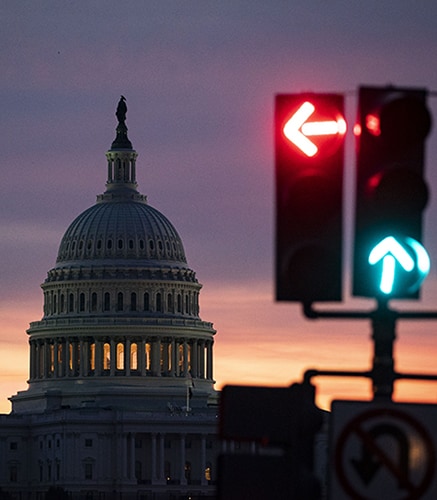The One Big Beautiful Bill Act contains significant tax changes for individuals, businesses and charitable organizations.
After weeks of negotiations in the House and Senate, President Trump signed the One Big Beautiful Bill Act (OBBBA) into law, as planned, on the Fourth of July. At its core, the tax provisions of the bill are an extension of key provisions from the 2017 Tax Cuts and Jobs Act (TCJA) that were scheduled to sunset at the end of 2025, with significant implications for individuals, businesses and business owners, and charitable organizations.
Below, we provide insights and analysis of the key tax provisions of the One Big Beautiful Bill Act and, where applicable, associated wealth planning opportunities.
IMPACTS ON INDIVIDUALS
Permanent Increase to the Estate, Gift and GST Tax Exemption
Exemptions were raised for 2026 to $15 million for individuals and $30 million for married couples, indexed for inflation in future years, with no scheduled sunset.
Currently, exemptions for 2025 are $13.99 million for individuals and $27.98 million for married couples. Barring the OBBBA, the significantly increased exemptions from the TCJA would sunset at the end of this year — resulting in 2026 exemptions approximately halved, to $7.4 million for individuals and $14.8 million per couple. In stark contrast, the new, elevated exemption amounts have no built-in sunset provision and are indexed for inflation. This provides substantially elevated planning certainty.
Planning Opportunities
- Consider making additional lifetime gifts beginning in 2026 with the higher exemption amount.
- Note that the full range of estate planning techniques remains available with no changes to the rules, including the step-up in basis at death.
- When making gifts, consider opportunities for income tax planning through the use of trusts in which the trust is responsible for payment of income taxes. These are separate taxpayers, allowing for strategic positioning of income, deductions and state residency to achieve overall income tax efficiency in tandem with the estate planning opportunities of the trust.
Individual Income Tax Rates and Alternative Minimum Tax (AMT) Exemption Extended Indefinitely
Lower income tax rates introduced by the passage of the TCJA in 2017 are permanently extended for U.S. taxpayers, holding top tax rates at 37% and avoiding the TCJA sunset reversion to 39.7%.
Under the OBBBA, only the lowest two brackets, of 10% and 12%, are indexed for inflation. Notably, the OBBBA extends the TCJA’s higher AMT exemptions. However, the exemption will be phased out at twice the rate as under the TCJA for higher income taxpayers ($500,000 for single filers, $1 million for married filing jointly).
Planning Opportunities
- Work with your advisors to determine when it is most advantageous to receive income or incur deductible expenses based on income tax brackets in order to minimize taxes across years.
- Doing so will be particularly important when claiming new deductions dependent on income levels, such as the new senior deduction for those over 65.
Temporary Increase in State and Local Tax Deduction Limit
The OBBBA temporarily increases the TCJA’s cap on deductions for state and local taxes (SALT) from $10,000 to $40,000 for 2025, with 1% annual increases for 2026-2029 for those making less than $500,000. In 2030, the SALT deduction cap reverts to $10,000.
For those making more than $500,000, the added $30,000 deduction is phased out. However, the final version of the legislation made no changes to the passthrough entity tax deduction, leaving certain SALT cap workarounds intact.
Planning Opportunities
- Those with income above $500,000 can consider shifting income and/or deductions to ensure they fall under the $500,000 phaseout during the 2025-2029 period.
- Income from non-grantor trusts is not included on the donor's tax return, making it easier for those who use them to stay under the $500,000 threshold. Moreover, non-grantor trusts are separate taxpayers and entitled to SALT deductions.
- Generating state and local taxes in passthrough entities can change when and how they are deductible, providing potential relief from the SALT cap.
Increased Standard Deduction, and Other Changes to Itemized Deductions
Like the TCJA, the OBBBA continues to favor the standard deduction over itemized deductions. Beginning this year, the standard deduction rises to $15,750 (from $15,000) for individuals and $31,500 (from $30,000) for married couples filing jointly, indexed for inflation.
Additionally, the OBBBA indefinitely extends the TCJA’s repeal of the individual exemption and limitations on deductions for gambling losses, moving expenses, casualty losses and business losses of non-corporate taxpayers. The child tax credit is increased to $2,200, and the refundable portion is increased to $1,400, with enhancements to the adoption credit.
For those in the top income tax bracket, the OBBBA includes an incremental reduction of the tax benefit from itemized deductions and places a floor on the charitable contribution deduction.
Additionally, the OBBBA contains several other new deductions that are limited to years 2025-2028 and phase out for higher-income taxpayers:
- A bonus deduction of $6,000 for seniors over 65
- Deductions for certain tip and overtime income
- A deduction up to $10,000 in interest on loans used to purchase domestic vehicles
Note that the senior deduction and the deductions for tip and overtime income are available to non-itemizers as well as itemizers.
Planning Opportunities
- Those in the highest tax bracket can consider accelerating payment of deductible expenses into 2025 to avoid the reduced benefit of itemized deductions for 2026.
- Taxpayers on the margin between the standard deduction and itemizing can consider strategically bunching itemized deductions in certain tax years in order to maximize the benefit.
The Elimination of Clean Energy Tax Credits for Individuals
The OBBBA repeals the clean energy tax incentives enacted as part of the Inflation Reduction Act.
Provisions repealed include clean energy car credits (for vehicles acquired after September 30, 2025) as well as energy-efficient home improvement and new home credits (which end for items placed in service after December 31, 2025). This leaves a short window for taxpayers to take advantage of these credits before they expire.
Trump Accounts
The OBBBA creates a new savings vehicle, the Trump Account, an IRA for minors.
There are limits on the permitted investments, and no withdrawals are allowed before the beneficiary turns 18. However, these new accounts allow family members to donate up to $5,000 in aggregate, per year, to a beneficiary’s account. Additionally, the OBBBA creates a pilot program for government contributions of $1,000 for children born between 2025-2028 as well as provisions that allow state, tribal and local governments and non-profits to make contributions.
Planning Opportunities
- The effective date for this provision is July 2026, but parents of children born in 2025 can claim the government contribution.
- Beginning in 2026, new accounts can be created by donors, but, as noted, the aggregate annual contributions from all individuals cannot exceed $5,000 per child. There are no income limitations on eligibility.
New Opportunity Zones
The OBBBA creates new opportunity zones, with the ability to defer recognition of, and even exclude from income, capital gains invested in a qualified opportunity fund.
New zones will be created on a rolling 10-year basis for investment after 2027, when those created under the TCJA are scheduled to end.
Planning Opportunities
- For sales that would generate capital gains before the effective date for the new qualified opportunity funds, consider using an installment sale so that gains recognized after 2026 can be invested in a new fund.
IMPACTS ON BUSINESSES
Investment and Hiring Incentives
The OBBBA creates multiple business incentives, including extending the deduction for qualified business income available to owners of passthrough entities and enhanced employer tax credits for paid Family Medical Leave Act leave and employer-provided childcare. The TCJA’s increased cap on deductions for business interest (the “EBITDA rule”) that sunset in 2022 is reinstated. This increases the allowable deduction, retroactive to 2022.
Under the TCJA, bonus depreciation had dropped to 40% for 2025 and was scheduled to be fully eliminated by 2027. However, the new legislation brings back 100% bonus depreciation permanently. Research and development costs can now be fully expensed in the year incurred, and the limitation for section 179 deductions for depreciable business property is increased to $2.5 million from $1.25 million.
Planning Opportunities
- Qualified investments in assets and product development can be timed to coordinate with both expected revenue and the effective dates for new limits on expensing and bonus deprecation.
- Corporations can consider amending returns for open years after 2022 in order to claim refunds based on the change in the cap on the business interest deduction.
The Elimination of Clean Energy Tax Credits for Businesses
Business tax credits for clean energy, including clean energy production and clean electricity production credits, are eliminated.
The provisions of the Green New Deal are repealed, with staggered effective dates between December 31, 2025 and 2027. Businesses investing in energy production, clean energy improvements and energy storage will want to review the effective dates as well as the limitations on benefits for foreign-controlled or foreign-influenced entities.
Planning Opportunities
- Businesses with clean energy projects or investments should consider accelerating project completion or making qualifying purchases before the corresponding credits expire.
Qualified Small Business Stock (QSBS) Enhancements
More businesses can qualify as QSBS, allowing shareholders to exclude a portion of their capital gains from income when shares are ultimately sold.
As noted, the OBBBA changes the gross asset threshold to be considered a “small business” from $50 million to $75 million, increases the cumulative per-taxpayer gain exclusion from $10 million to $15 million, and allows a partial benefit after only three years instead of five.
Planning Opportunities
- Businesses can consider choice of entity in order to qualify their stock for this treatment, which is available to C corporations.
- Note that investors in start-ups and employees receiving equity compensation have significantly escalated planning flexibility given the partial benefit after the three year holding period.
IMPACTS ON CHARITIES AND DONORS
Increased Tax on University Endowments and Changes to Charitable Deductions
The new legislation increases the tax on university endowments, with a sliding rate between 1.4% and 8%, depending on the school’s endowment per student.
Note that schools with fewer than three thousand students are excluded from the tax increase. As a result of the calculation method, schools with significant foreign student populations will face higher taxes.
Additionally, the OBBBA allows a limited charitable contribution deduction of $1,000, applicable even for non-itemizers beginning in 2026. There is also a new tax credit for contributions to scholarship organizations.
Charitable contributions by corporations and individuals in the highest tax bracket are subject to new floors beginning in 2026 — 1% for corporate donors and 0.5% for individuals in the 37% bracket.
Planning Opportunities
- Donors to colleges and universities can consider making gifts to a donor advised fund, charitable trust, or foundation that makes annual distributions to the school to avoid contributing to the endowment.
- Donors subject to the floor on charitable deductions in 2026 can accelerate donations into 2025 to avoid this limitation.
- Donors who do not itemize can postpone charitable deductions until 2026, when they will qualify for up to a $1,000 deduction.
As noted, a significant benefit of the new legislation is the relative certainty that many of its provisions will remain in effect indefinitely, removing the complexities of planning around potential looming sunsets. Given the staggered effective dates for many of the provisions, however, it is important to consult with your advisors in order to optimize planning for transactions based on the effective dates.



